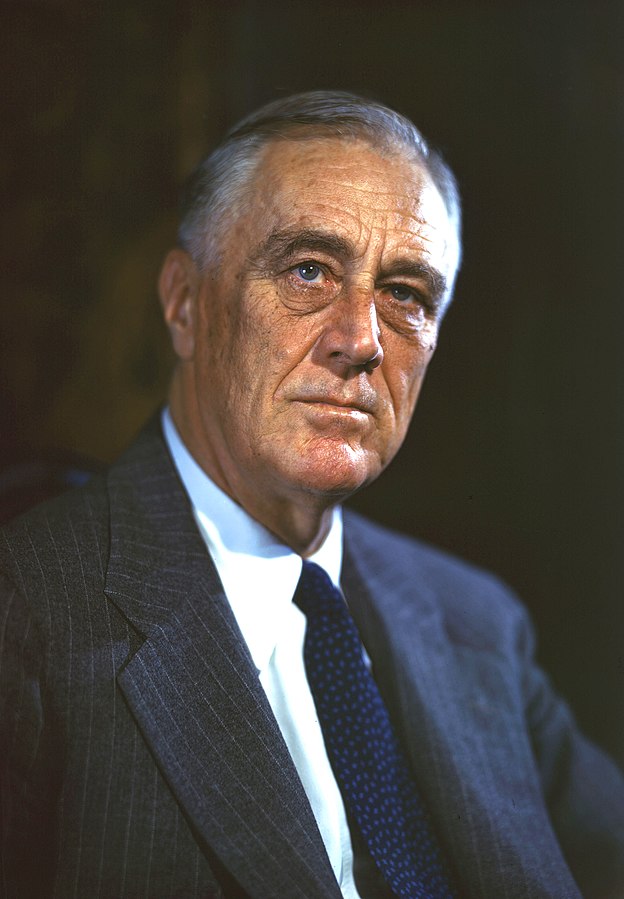dd
by Peter Shinkle
Amid all the momentous battles and horrific tragedies of World War II, American political events in that era are often overlooked. However, during the war years, the American political system experienced its own violent earthquake far away from the armed conflicts abroad.

This file is licensed under the Creative Commons Attribution 2.0 Generic license.
Prior to the war, the Democratic Party dominated the South, where Democratic leaders upheld white supremacy through segregationist Jim Crow laws that denied Black citizens their rights in areas ranging from voting and education to transportation and employment. The party led the Confederacy through the Civil War and subsequently controlled what was dubbed “the solid South.”
After relying on southern support to win the election in 1932, FDR took no significant steps to break with his party’s support for white supremacy. First Lady Eleanor Roosevelt created goodwill with Black Americans through actions such as supporting singer Marian Anderson’s concert at the Lincoln Memorial in 1939, but FDR himself did very little to end America’s racial caste system in the early years of his presidency.
As he began to build support for the war against fascism, FDR formed a bipartisan alliance with moderate Republicans, including Henry Stimson, whom he appointed secretary of war in 1940. FDR and Stimson refused to desegregate the U.S. Army, rejecting pleas from the NAACP and its attorney, Thurgood Marshall, and other civil rights leaders that they do so.
However, in June 1941, FDR and Stimson met with A. Philip Randolph, a Black union leader and civil rights activist, as well as their mutual Republican ally, New York City Mayor Fiorello La Guardia. Randolph urged the administration to end the segregation of workers in the vast industries making planes, tanks, and ships for the U.S. military. As the meeting unfolded, FDR and Stimson both agreed to desegregate the war industries, which soon led to a watershed moment in civil rights history.
On June 25, 1941, FDR signed an executive order creating the Committee on Fair Employment Practices (FEPC), which was tasked with investigating complaints of discrimination in the war industries and taking “appropriate steps to redress grievances which it finds to be valid.” For the first time, the machinery of the federal government was put to work on ending racial discrimination in employment.
Within weeks, war industry firms announced plans to hire Black employees; many refused to do so for most jobs prior to this. By early 1942, the FEPC began issuing orders to federal contractors requiring them to hire Black workers as well as those of Jewish, Italian, or German origin.
Civil rights activists hailed this as an advance in racial equity in America. Southern Democrats, however, railed against the FEPC, warning that its attacks on segregation would cause violence and lead southerners to abandon the Democratic Party.
In 1943, these party divisions intensified, as northern Democrats urged the passage of bills to ensure that all overseas soldiers – as many as 10 million of them were expected to be abroad in late 1944 – could vote in the 1944 election using a “federal ballot.”
Black newspapers reported that the federal ballot would permit large numbers of Black soldiers – who were so widely denied the ballot under Jim Crow laws — to vote. Southern Democrats erupted, charging that the federal ballot would trample on state election laws. They denounced the bills, insisting in no uncertain terms that “white supremacy” must remain intact, and called for a defense of “states’ rights.”
Senator Josiah Bailey threatened that if liberal Democrats continued pushing a Roosevelt bill, southern Democrats would leave the party. “If we must be in a party in which we are scorned as southern Democrats, we will find a party which honors us.”
As FDR led the global war against fascism, his party was wracked by division over racial politics and civil rights. Some southern Democrats called for the party to reject FDR and support a southern segregationist, Senator Harry Byrd of Virginia, for the presidency.
After months of bitter debate, Congress passed a compromise that would permit a federal ballot to be used only by soldiers from states where the governor agreed to allow it. FDR begrudgingly accepted the compromise. Ultimately, only 20 governors approved the federal ballot. FDR won the election of 1944 handily, and there is no evidence the soldier vote was a significant factor in the outcome. Southern Democrats continued their attack on the FEPC and ultimately succeeded in dismantling the agency.
The leadership of the Democratic Party, however, had crossed the Rubicon—and it would not abandon civil rights. After Roosevelt died in April 1945, his successor Harry Truman carried forward the party’s support for the cause, issuing an executive order to desegregate the Army in 1948. That year, southern Democrats created a third party, known as the Dixiecrats, supporting segregationist Strom Thurmond of South Carolina in his candidacy for president. Republicans saw an opportunity to win votes in the South, and when General Dwight D. Eisenhower ran for president in 1952, southern segregationists threw their support behind him.
Democratic Presidents John F. Kennedy and Lyndon B. Johnson continued on the path charted by FDR, supporting equal rights for Black people. In 1964, Johnson signed the Civil Rights Act into law, and Senator Strom Thurmond announced he had switched to the Republican Party. The following year, Johnson signed the Voting Rights Act, protecting the rights of all citizens to vote—a cap on the issue that caused the Democratic Party’s schism in 1943-1944.
The massive shift of Democratic segregationists and other conservatives into the Republican Party continued over the following decades. Republicans, including President Richard Nixon, sought the support of segregationists and worked to expand the power of the Republican Party in the South. They vowed to support states’ rights, the rallying cry of the soldier-vote dispute of 1944. When George W. Bush won the election in 2000, he carried every state in the old Confederacy. The South was once again “solid,” though now it was solidly Republican.
I refer to the events by which the two parties traded places as the “Roosevelt Inversion,” because it began when the Democratic president embraced civil rights, causing civil rights supporters to shift into the Democratic Party and segregationists to shift into the Republican Party. Begun in the crucible of war, this story is long, forgotten, and misunderstood, but you can see its outcome when you look at America’s political map today.
Peter Shinkle worked for 19 years as a reporter at various news organizations, including most recently the St. Louis Post-Dispatch. He covered the federal court system, and also wrote investigative stories on subjects ranging from improper disposal of radioactive waste to contamination spread by a lead mining company. He is the author of Ike’s Mystery Man: The Secret Lives of Robert Cutler.

